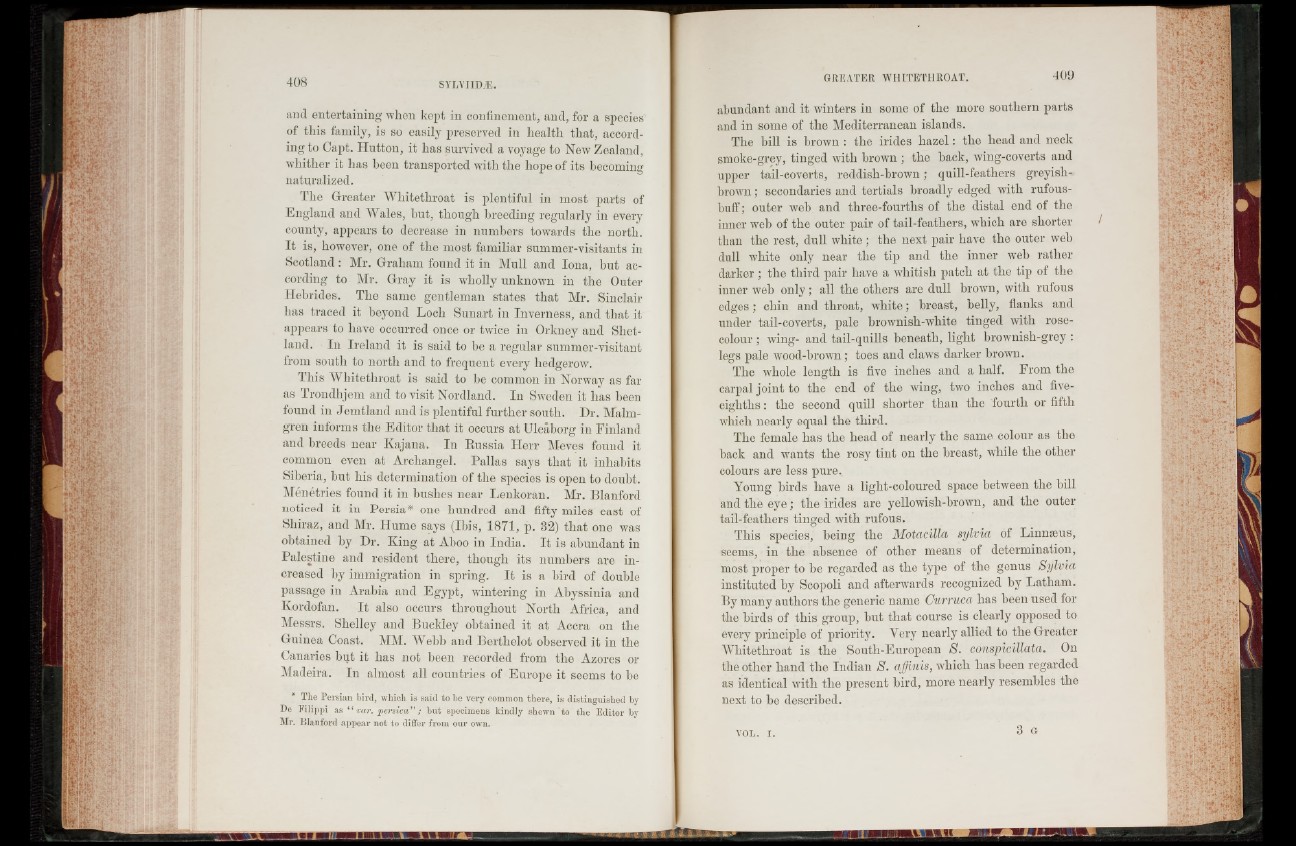
408 SYI/VIIDyE.
and entertaining when kept in confinement, and, for a species
of this family, is so easily preserved in health that, according
to Capt. Hutton, it has survived a voyage to New Zealand,
whither it has been transported with the hope of its becoming
naturalized.
The Greater Whitethroat is plentiful in most parts of
England and Wales, but, though breeding regularly in every
county, appears to decrease in numbers towards the north.
I t is, however, one of the most familiar summer-visitants in
Scotland: Mr. Graham found it in Mull and Iona, hut according
to Mr. Gray it is wholly unknown in the Outer
Hebrides. The same gentleman states that Mr. Sinclair
has traced it beyond Loch Sunart in Inverness, and that it
appears to have occurred once or twice in Orkney and Shetland.
In Ireland it is said to be a regular summer-visitant
from south to north and to frequent every hedgerow.
This Whitethroat is said to he common in Norway as far
as Trondhjem and to visit Nordland. In Sweden it has been
found in Jemtland and is plentiful further south. Dr. Malm-
gren informs the Editor that it occurs at Uleaborg in Finland
and breeds near Kajana. In Russia Herr Meves found it
common even at Archangel. Pallas says that it inhabits
Siberia, but his determination of the species is open to doubt.
Menetries found it in bushes near Lenkoran. Mr. Blanford
noticed it in Persia* one hundred and fifty miles east of
Shiraz, and Mr. Hume says (Ibis, 1871, p. 32) that one was
obtained by Dr. King at Aboo in India. I t is abundant in
Palestine and resident there, though its numbers are increased
by immigration in spring. It is a bird of double
passage in Arabia and Egypt, wintering in Abyssinia and
Kordofan. I t also occurs throughout North Africa, and
Messrs. Shelley and Buckley obtained it at Accra on the
Guinea Coast. MM. Webb and Berthelot observed it in the
Canaries but it has not been recorded from the Azores or
Madeira. In almost all countries of Europe it seems to he
* The Persian bird, which is said to be very common there, is distinguished by
De Filippi as “ var. persica” ; but specimens kindly shewn to the Editor by
Mr. Blanford appear not to differ from our own.
GREATER W HITETHROAT. 409
abundant and it winters in some of the more southern parts
and in some of the Mediterranean islands.
The bill is brown : the irides h az el: the head and neck
smoke-grey, tinged with brown ; the back, wing-coverts and
upper tail-coverts, reddish-brown; quill-feathers greyisli-
brown ; secondaries and tertials broadly edged with rufous-
buff ; outer web and tliree-fourths of the distal end of the
inner web of the outer pair of tail-feathers, which are shorter
than the rest, dull white; the next pair have the outer web
dull white only near the tip and the inner web rather
darker; the third pair have a whitish patch at the tip of the
inner web only; all the others are dull brown, with rufous
edges; chin and throat, white; breast, belly, flanks and
under tail-coverts, pale brownisli-wliite tinged with rose-
colour ; wing- and tail-quills beneath, light brownish-grey :
legs pale wood-brown; toes and claws darker brown.
The whole length is five inches and a half. From the
carpal joint to the end of the wing, two inches and five-
eighths : the second quill shorter than the fourth or fifth
which nearly equal the third.
The female has the head of nearly the same colour as the
back and wants the rosy tint on the breast, while the other
colours are less pure.
Young birds have a light-coloured space between the bill
and the eye; the irides are yellowish-brown, and the outer
tail-feathers tinged with rufous.
This species, being the Motacilla sylvia of Linnaeus,
seems, in the absence of other means of determination,
most proper to he regarded as the type of the genus Sylvia
instituted by Scopoli and afterwards recognized by Latham.
By many authors the generic name Curruca has been used for
the birds of this group, hut that course is clearly opposed to
every principle of priority. Very nearly allied to the Greater
Whitethroat is the South-European S. conspicillata. On
the other hand the Indian S. ajftnis, which has been regarded
as identical with the present bird, more nearly resembles the
next to be described.
VOL. I.